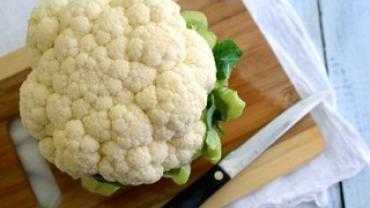
If cauliflower wasn’t so ‘unflashy’ with its dull white hue it would be the redheaded stepchild of the edible plant world. More boldly colored vegetables and fruits proudly display their beneficial compounds: anthocyanins in blueberries cranberries and blackberries; carotenes in sweet potatoes and carrots; magnesium in dark leafy greens; and resveratrol in dark grapes and red wine. But don’t be fooled by cauliflower’s unassuming appearance. The absence of color doesn’t mean there’s an absence of nutrients. This versatile vegetable shares many of the beneficial properties of its Brassica brethren and it’s time to give it its due.
Like all its cruciferous cousins—which include broccoli cabbage kale Brussels sprouts kohlrabi and more—cauliflower is descended from wild cabbage believed to have originated in what is now Turkey. It serves up a good amount of vitamin C folate vitamin K1 and fiber. Plus its extremely low glycemic load makes it an ideal vegetable for reduced-carbohydrate diets. If you’ve been watching your carb intake but find yourself missing foods like mashed potatoes and rice look no further. Low-glycemic versions of your starch-based favorites require nothing more than cauliflower and a little creativity. After a quick whirl in a food processor cauliflower can be made into couscous or stir-fried with meat and vegetables as a mock “fried rice.” Long-time low-carbers might be familiar with “fauxtatoes”—cauliflower steamed until very soft then puréed and combined with butter cream milk or sour cream to approximate the flavor and texture of mashed potatoes. And even if you don’t compost your vegetable scraps don’t automatically ditch the outer leaves—they’re edible too!
For those seeking milder fare cauliflower is still a great option: its low caloric density and high water content mean you can eat a substantial portion of it without racking up excessive calories. For all of these reasons cauliflower fits perfectly into many different dietary strategies: vegetarian low-carb Paleo and of course plain and simple “healthy eating.”
Aside from serving as a vehicle for keeping things interesting at dinnertime cauliflower brings some pretty impressive health benefits to the table as well. It’s a good source of sulfur which your nose will confirm for you if you steam it a little too long. Cabbage and broccoli are usually the first vegetables that come to mind under the cruciferous category but cauliflower runs right alongside. The sulfur these foods provide is critical for supporting detoxification processes in the liver. Beyond that cruciferous vegetables are also known as rich sources of glucosinolates which are sulfur-containing compounds that have a number of health-promoting properties. One of the most widely studied is indole-3-carbinol (I3C) a compound that may help the body reduce harmful storages of excess estrogen.
The method you use to cook cruciferous vegetables can affect the amount of these helpful compounds that remain in the final dish. In boiling a significant amount of glucosinolates are lost to the cooking water. This isn’t an issue if the water is used in the final dish such as for a soup or stew. Otherwise steaming or stir-frying will preserve more of these beneficial components (just make sure your steamer basket is above the level of the water). Of course cauliflower can also be consumed raw in salads or with dip. Raw cruciferous vegetables can be tougher to digest than well-cooked so if you experience bloating or flatulence you may prefer to stick to cooked cauliflower. One thing to note – eating large amounts of raw cruciferous vegetables has been associated with lower thyroid function. In their raw state these foods contain goitrogens—substances that may interfere with the absorption of iodine. This however is not a reason to avoid these otherwise extremely nutritious foods. Just stick to cooked. (Raw cauliflower and broccoli are awfully hard to chew anyway! Plus they taste better roasted with olive oil and a little sea salt or steamed with a nice pat of butter.)
Lest you think cauliflower only comes in the white variety if you visit a farmers’ market you might be treated to the sight of cauliflower in colors you’ve never seen before such as purple yellow-orange (which is higher in beta-carotene than white) and Romanesco which is almost neon green and has a slightly more “spiky” appearance than the rounder and more common cauliflowers. But even the humble white variety that inhabits most supermarkets isn’t so humble anymore.
For some great recipes to get you thinking about how to spice up the blank canvas that is cauliflower check out this diverse collection.
Sources